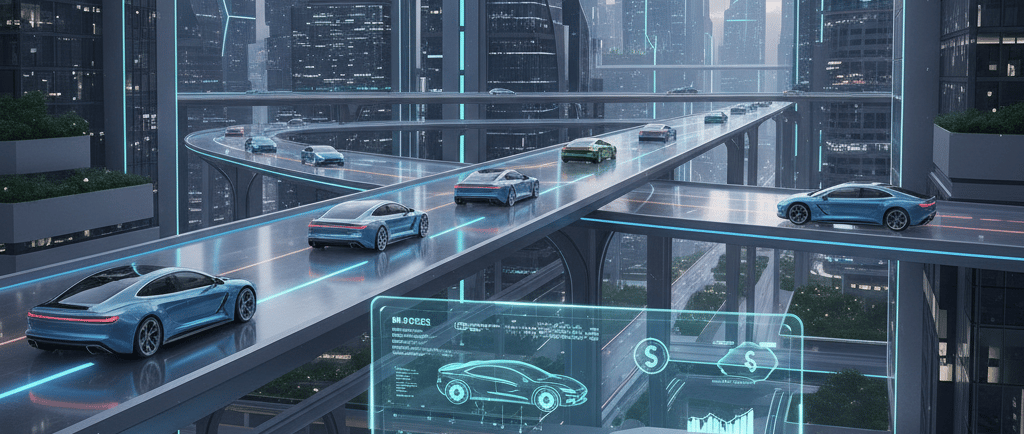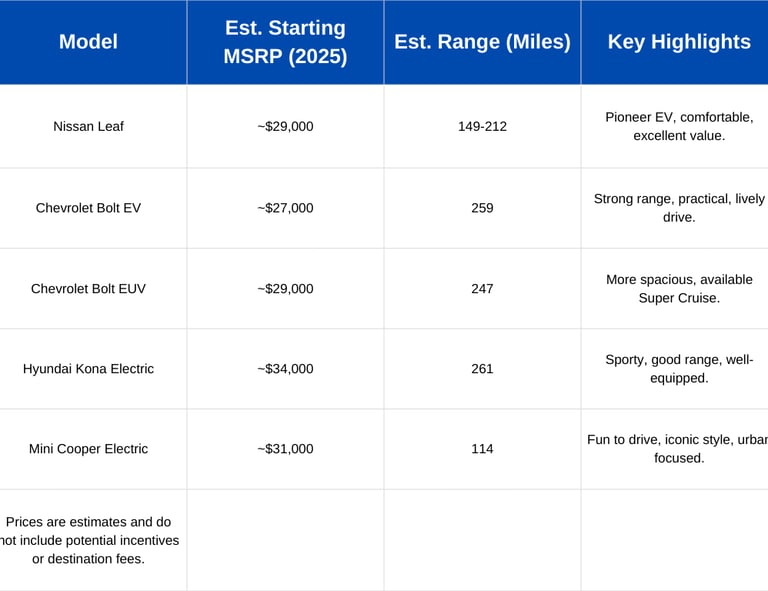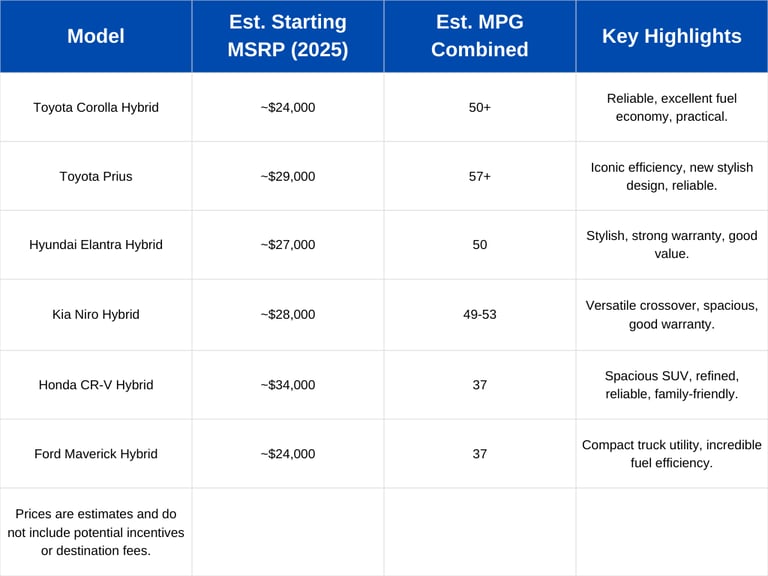The Best Cheap Electric and Hybrid Cars to purchase in 2025
EV
BIT WISE REVIEWS
10/7/2025


The car world is changing swiftly, and 2025 is becoming a defining year for all environmentally responsible drivers, as well as tech enthusiasts. There are no days when electric vehicles (EVs) and hybrids were only luxurious and costly. Nowadays, more manufacturers are providing new, efficient, yet surprisingly affordable models, which allow even more people to make sustainable driving accessible. Those who just consider using an affordable electric or hybrid vehicle in order to help decrease their carbon footprint without spending much money on it, those who consider buying the latest in automotive technology, or those who are simply interested in what the future of affordable electric and hybrid cars will bring in 2025, the market will be more vibrant than ever before. This all-inclusive guide will lead you through the most affordable options, investigate the key incentives, and make you realize why the switch of 2025 can be called a smart decision.
Key Takeaways
Affordability Here: In 2025, various models of electric cars and hybrids will be sold at a good price, and green driving will become more affordable than it has ever been before.
Policies and incentives do not work well: Federal tax credits, state rebates, and local incentives have the potential to make an EV or hybrid purchase or lease much more affordable.
Various Selections: Small electric cars are ideal to drive around the city, whereas hybrid SUVs can fulfil any need and lifestyle.
Saving More Than a Price Tag: EVs and hybrids can benefit the pocketbook in the long run by saving fuel costs, maintenance, and other incentives, such as the hours off in HOV lanes.
Flexibility in Leasing: In 2025, one can lease an electric car and pay less monthly and have access to the latest technology, yet does not have to commit to car ownership as in an ownership scenario.
Why Go Electric or Hybrid in 2025?
The choice of purchasing a new car is usually between cost, performance, and ecological effects. Electric and hybrid vehicles pose a strong case in every aspect of the market in 2025. In addition to the more apparent environmental effects of reduced emissions, these vehicles also provide more tangible benefits that will attract a very wide range of purchasers, including tech enthusiasts and budget-conscious families.
Sustainability & Environmental Impact
Making an electric or a hybrid car choice is a personal move towards making a personal carbon footprint. Electric cars generate zero tailpipe emissions, thus helping to make our communities cleaner. Although hybrids still run on gasoline, they have a much higher fuel efficiency and much lower emissions than regular gasoline vehicles. The higher the percentage of renewable sources of electricity, the greater the environmental value of EVs will be.
Cost Reductions and Money Saving roller
It is here that the affordable part really comes out.
Saving of Fuel: Electricity tends to be cheaper per mile as compared to gasoline, and hybrids significantly reduce the amount of fuel being used. Can you imagine not going to the gas station so much?
Reduced maintenance: Electric vehicles have fewer moving components compared to gasoline engines, and therefore less maintenance will be required, such as changing oil, changing spark plugs, gs, and other complicated engine repairs.
Incentives: Since we will further explain, there are numerous government initiatives that provide substantial financial incentives, such that the first purchase will become easier.
Resale Value: Since the demand of green cars is increasing, the resale value of these cars is likely to be high.
Driving Experience & Technology approach
The advanced technology is loaded in modern EVs and hybrids. Electric cars have immediate torque, which offers rapid acceleration and a smooth and quiet ride. The hybrids provide a smooth transition from electricity to gas. Most of them include state-of-the-art infotainment, driver-assistance, and connectivity features that are directly desired by gadget consumers and tech experts. These are cars, essentially, rolling computers, with sophisticated infotainment systems and high-end driver-assist systems, just as many tech-oriented users depend on their high-end laptops and PCs in their work every day.
Learning about EV & Hybrid Classifications.
However, it is useful to give a brief overview of the various types of electrified cars you will see in 2025 before delving into the specific models:
Battery Electric Vehicles (BEVs): These are also all-electric, powered by a battery and an electric motor. They have zero emissions, and they are powered by plugging into an external power source. They can be the Nissan Leaf and Chevrolet Bolt EV.
Plug-in Hybrid Electric Vehicles (PHEVs): PHEVs have a gas engine in combination with an electric motor, along with a bigger battery compared to the usual hybrids. They can operate on electricity only over a long distance (usually 20-50 miles) and then switch on to hybrid operation, which utilizes gasoline and regenerative braking to offer a wider range. They are chargeable by plugging.
Hybrid Electric Vehicles (HEVs): Technically referred to as hybrids, these vehicles have a gasoline engine and an electric motor that are combined. The battery size is smaller, and it is mostly recharged through regenerative braking and a gasoline engine. They are not plug-in, and their all-electric range is usually very small, with the exception of helping the gasoline engine to achieve higher fuel efficiency. They include the Toyota Prius and the Hyundai Elantra Hybrid.
Finding Your Way around Electric Vehicle Incentives in 2025.
The range of incentives that are offered is one of the most important reasons why electric and hybrid cars will be affordable in 2025. These may reduce the effective purchase or lease price significantly. It is important to know these programmes in order to maximise your savings.
Federal Tax Credits 🇺🇸
Eligible new clean vehicles still receive tax credits from the U.S federal government. These credits will reach up to 7500 dollars for new EVs and PHEVs as of 2025. Nevertheless, one should remember several rules:
Manufacturer Caps: There are manufacturer caps, which may be a manufacturer reaching their qualifying vehicle threshold, and as a result, their cars do not qualify for the full credit given by the manufacturers. The updated IRS guidelines need to be checked.
Price Limits of the vehicles: The Manufacturer Suggested Retail Price (MSRP) of the vehicle should be less than a specific amount (e.g., for sedans: 55,000, SUVs/trucks: 80,000).
Battery Component and Critical Mineral Sourcing: A good percentage of the battery parts and the critical minerals will have to be procured in North America or free-trade agreement partners of the U.S. to receive the entire credit. Factor is ever-changing, and thus, it is important to ensure that the eligibility is checked.
Buyer Income Limits: There are income limits on individuals and households who are to qualify for the credit.
Point-of-Sale Transfer: This is a significant amendment that will take place in 2025: It will be possible to transfer the tax credit to the dealer at the point of sale to reduce the down payment or amount of financed funds in real-time, without waiting until tax season.
State/Local Rebates/Incentives protocol.
In addition to the federal programmes, most states, cities, and even local utility companies have their own incentives. These can include:
State Tax Credits or Rebates: Back money directly after purchase or a State tax credit.
HOV Lane Authorization: This is an authorization that allows vehicles with one occupant to use HOV lanes.
Lower Registration Costs: Lower registration charges than gasoline cars.
Charging Station Rebates: This will provide a subsidy towards installing a home EV charger.
Utility Company Programs: Select electric utilities have incentive rates on the off-peak charging of EVs or rebates to install EV chargers.
Never stop doing your research on the particular incentives in your state and locality. These may contribute to huge savings! 💡
Regarding these incentives, it is always prudent to refer to official government sources and our disclaimer to know the most up-to-date and accurate information about them since they may evolve.
The best cheap electric cars of 2025
Affordable electric cars are now at a mature stage in the market, with a variety of choices that compromise between cost, practical range, and features. The following are some of the best prospective competitors in 2025:
1. Nissan Leaf 🍃
Nissan Leaf has been a price-setter in the affordable EV market, and it still presents a great value in 2025.
Why it is Cheap: It is frequently the cheapest EV on the market, and in particular with incentives.
It has a range of about 149 miles, and Leaf Plus has a range of about 212 miles, which is enough to cover most of the daily commutes.
Features: The car is known to have a comfortable ride as well as a spacious interior. It is equipped with Nissan Safety Shield 360, a set of driver-assist technologies.
Target Audience: Suits city residents, first-time EV purchasers, and those who have a daily commute schedule.
2. Chevrolet Bolt EV & Bolt EUV ⚡
The Bolt models provide decent range and versatility at a reasonable price of Chevrolet models.
Why it is Affordable: The two models are competitively priced, particularly due to their capabilities and scope, which makes them good candidates for the federal and state subsidies. Range: The Bolt EV has an approximate range of 259 miles, and the Bolt EUV, with a slightly increased size, has an approximate range of 247 miles.
Features: Both models have an energetic driving experience, plenty of technology, such as a huge infotainment display, and a surprisingly spacious cabin. The EUV provides the benefit of some extra passenger space and a Super Cruise hands-free driving system on some trims.
Target Audience: The best model to choose is one that suits small families, those who need to cover more miles, and drivers who are techno-savvy, and of course, want their cars to be aids to driving.
3. Hyundai Kona Electric 🔋
Kona Electric has established a niche as a stylish and peppy subcompact EV.
Why it is Affordable: Has good range, performance and features at its price.
Threshold: It covers a distance of approximately 261 miles, which is good in its segment.
Features: Has a rapid acceleration, agile handling and interior is well furnished with user friendly technology. Normal safety provisions are also an added advantage.
Target Audience: Suits well those living in the urban area, who love a sporty drive and who want a smaller SUV shape.
4. Mini Cooper Electric (Mini Cooper SE) 🏁.
To the people who value driving fun and iconic style, the Mini Cooper Electric provides a different proposition.
Why it is Affordable: It is a premium brand, though the lowest price is competitive amongst EVs, particularly taking into account its regular features and brand visibility.
Range: Its estimated range stands at about 114 miles, which is the lowest compared to its competitors, but sufficient to cover city driving and shorter commutes.
Attributes: Provides the traditional Mini go-kart control, an upscale interior, and an unexpected fun on-road experience. It's truly a driver's EV.
Target Audience: Urban drivers, fashion-conscious people, and those who are more interested in the driving dynamics rather than the maximum range.
5. Other Emerging Contenders
Watch out for possible new entries or new models of the manufacturers such as Volkswagen (ID.4 base model), Mazda (MX-30), and possibly new Chinese brands entering the U.S. market with competitive products in 2025.
Instead, they offer a brief comparison table summarising affordable EVs of the year 2025
Read more: NVIDIA RTX 5090: A New Era in GPU Performance
Best Hybrid cars under 1000 dollars in 2025
Affordable hybrid vehicles in the year 2025 can provide a win-win solution to those who are not yet prepared to get a full EV or require a long range and no range anxiety: high fuel efficiency and the feeling of comfort of being able to refuel their gasoline-powered cars the old-fashioned way.
1. Toyota Prius / Corolla Hybrid 🌿
Toyota is the undisputed leader in hybrid technology, and its products are always at the top in terms of efficiency and reliability.
Why It is Affordable: The two models come with the highest fuel economy in the market and at reasonable prices, which means that they would save a lot of fuel in the long run.
Fuel Economy: The Corolla Hybrid has a combined fuel economy of above 50 MPG, and the Prius has a habit of going over that, with certain models almost reaching 57 MPG combined.
Features: They are bulletproof, have extensive safety suites (Toyota Safety Sense), and cosy, utilitarian interiors. The newest Prius also has a remarkably smooth design.
Target Audience: Commuters, families, and any person who cares about fuel efficiency, reliability, and low running costs.
2. Hyundai Elantra Hybrid 🌟
The Elantra Hybrid provides a more stylish option that has a high fuel economy and a huge warranty.
Why it is Affordable: It is competitively priced, and it has a great fuel economy, meaning that it is a good sedan.
Fuel Economy: Maximum average of 50 MPG.
Features: Contemporary interior, user-friendly infotainment system, and a package of standard safety features. The Hyundai 10-year/100,000-mile powertrain warranty gives Hyundai peace of mind.
Target Audience: Customers who want a classy and high-performing compact car with a powerful warranty.
3. Kia Niro Hybrid
Kia Niro is a hybrid crossover that is extremely versatile, with the functionality of an SUV and fuel efficiency that is remarkable.
Why it is Affordable: It has useful space and good fuel economy at a lower price than many conventional compact SUVs.
Fuel Economy: It attains about 49-53 combined, with a slightly different fuel economy depending on the trim.
Features: Large and contemporary cabin, convenient technology, and comfortable ride. It also enjoys the great warranty of Kia.
Target Audience: Small families, adventurers, and anyone who needs more cargo capacity than a sedan without feeling a loss in fuel economy.
4. Honda CR-V Hybrid 🌲
In the case of people who require a bigger and more competent hybrid SUV, the Honda CR-V Hybrid provides.
Why it is Affordable: It is slightly more expensive than the smaller ones, but in terms of fuel economy, considering the size and the Honda reliability and practicality, the cost is affordable in the long term.
Fuel Economy: *Usually gets 37 MPG combined, which is really good in a compact SUV.
Features: The car is characterised by its large and comfortable interior, elegant driving dynamics, and its Honda Sensing arsenal of safety systems.
Target Audience: Family, those who require more space and the ability to travel in any weather, and those who are committed to the Honda brand.
5. Ford Maverick Hybrid 🚚
The Ford Maverick Hybrid is a unique product that combines the functionality of a compact pickup truck and has outstanding hybrid fuel efficiency.
Why it is Affordable: Its starting price is beyond competitive, and it is one of the cheapest new trucks in the market, not to mention the hybrid.
Fuel Economy: Records a very high 37 MPG combined, which is a record in a truck.
Features: A Useful bed, a cosy cab, and an impressive standard of technology at a comparatively low cost. It is really an urban utility car.
Target audience: All the small business owners, DIY enthusiasts, and people who have a real utility and unbelievable fuel efficiency.
Fast Comparison Table: 2025 Affordable Hybrids
Read more: Innovations in snore-blocking earbuds and their effectiveness
Leasing vs. Buying: Which is the best?
The question of whether to lease or purchase an affordable electric car or a hybrid one in 2025 is a serious one. There are peculiar advantages of each option:
Purchasing: Property & Value Over Time ℙ.
Advantages: You will be the owner of the car, customise, unlimited mileage, and equity. Once you pay off the loan, you no longer have any more car payments. This is usually the most suitable when you are intending to retain the car over a long period of time.
Cons: Increased monthly payments, depreciation, and you will be liable to all the maintenance and repairs once the warranty is out of form.
Leasing: Flexibility and the newest technology .
Advantages: Reduced monthly payments compared to purchase, will always have a new car with the latest technology every few years, and the lease will be covered with a warranty. Federal tax credits can also be easier to claim on an electric vehicle lease, but in some cases, dealers can include such on the lease agreement upfront.
Cons: No equity ownership, a limit on miles (additional charges for exceeding this limit), and you will be paying car payments continuously. Neither can you personalise the car.
For people who are fond of owning the best gadgets and technology, leasing an EV or hybrid in 2025 can be a great experience and can be close to the state of the art of automotive technology without a lengthy commitment.
The incorporation of intelligent devices is another important factor, which makes it easy to connect with your car, as the Google Pixel Watch 4 reinvents the wearable device connectivity.
The Future of Low-Cost Green Driving.
The shift towards cheaper electric and hybrid vehicles is bound to continue rising faster as we look further than 2025. The battery technology is still getting better, the manufacturing processes are becoming streamlined, and the competition among automakers is getting tougher. This translates to more options, extended distances, and reduced prices to the customers.
There is the possibility of additional improvements in charging infrastructure, and range anxiety will be a thing of the past. The technology in cars will keep on advancing, and such things as sophisticated artificial intelligence assistants, AR screens, and the ability to be fully connected with our online lives will become a common thing. Consider a scenario in which the display in your automobile will provide an experience similar to what has been accomplished in Augmented and Virtual Reality (AR/VR). Such technological advances, coupled with the continued government subsidies, give a very bright outlook on the future of affordable, sustainable transportation.
Read more: LG Signature Smart Instaview Microwave Kitchen Innovations
Conclusion
The year 2025 marks a significant turning point for affordable electric cars and affordable hybrid cars. Through an increasing variety of different models with impressive range, efficiency, and features, without having to pay a premium price, accompanied by strong electric vehicle tax credit and electric vehicle rebate programs, it has never been more attractive and accessible to switch to green driving. You can choose a fully electric car, a versatile plug-in hybrid, or an extremely efficient traditional hybrid, and you are guaranteed to find a sustainable alternative. Research, investigate the incentives, and prepare to drive cleaner, less noisy, and more economically in 2025.




INSIGHTS
Your go-to source for latest tech gadgets news
Support
Connect
© 2025. Bit Wise Reviews
+91 8003144011
